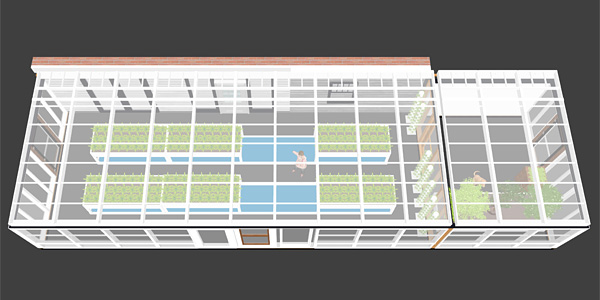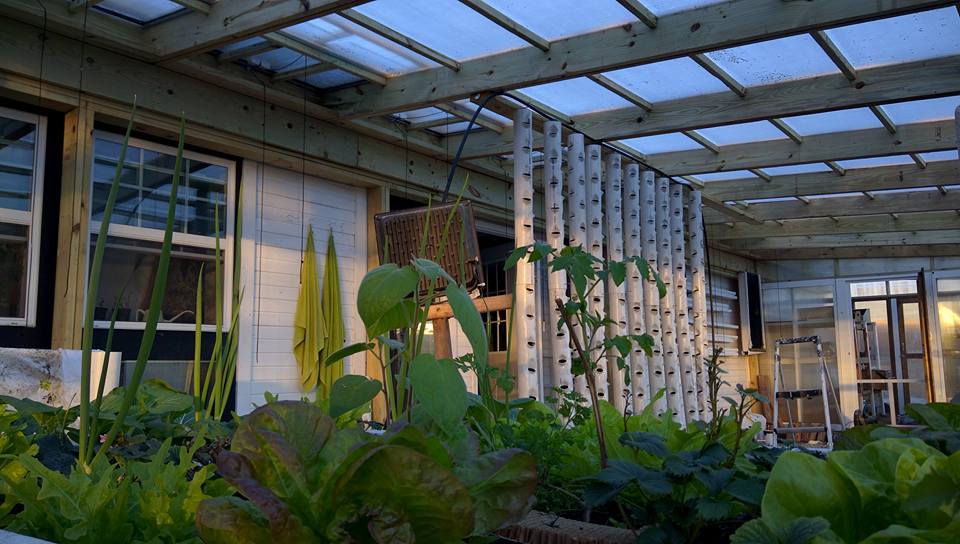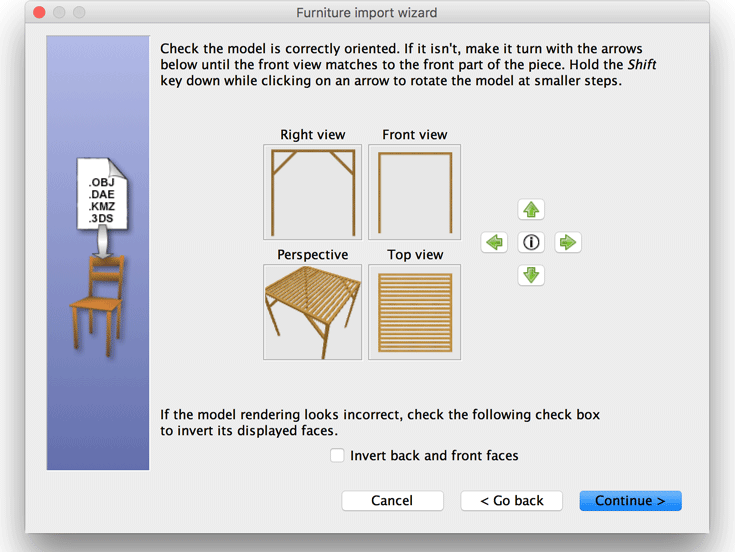And you, how do you use your Sweet Home 3D? Episode 10
Marcin Jakubowski created the Global Village Construction Set open source platform and uses Sweet Home 3D for his aquaponic greenhouse plans. Some months ago, he wrote on our facebook page to show his work in progress, and very recently, someone mention him in the forum while we were interviewing Marcin to know more about his great initiative.
– Can you briefly explain your project and what is the Global Village Construction Set?
In a world desperate for a cultural shift that can offer us a future beyond the inevitable crash of consumer civilization, those who have a better vision and those who have the knowledge and skill to bring ideas into fruition are finding it easier than ever to connect and make amazing things happen.
We have before us the great potential for the emergence of the “maker culture”, a culture where communities make what they need out of what they already have, using ideas and plans developed, tested and shared freely via open source.
Among the ranks of organizations who are actively bringing about this kind of societal transformation is Open Source Ecology (OSE), a Non-Governmental Organization and hive of engineers, architects, inovators, farmers, and forward thinking pioneers who are condensing more than 250 years of industrial knowledge into a single set of machines and tools that will allow individuals to accomplish industrial level infrastructure, machining, farming and energy projects on a small, local scale, using locally sourced and repurposed materials and biofuels. It’s called the Global Village Construction Set (GVCS).
See the TED Talk on the Global Village Construction Set in the following video: https://embed-ssl.ted.com/talks/marcin_jakubowski.html
The Global Village Construction Set focuses on modularity. We build modular machines and structures. Our construction is similar to pre-fab, but everything is fabricated on site, rather than in a factory. The walls are made of 4×8 foot modules and the roof is made of 4×16 foot modules. After modules have been built in the workshop, they are installed on site and coupled together — like legos.
– How Sweet Home 3D takes place in it ? Why and what for do you use it?
We focus on using open source tools in order to promote widespread collaboration — just like Sweet Home 3D has succeeded in doing. We are using Sweet Home 3D, FreeCAD, Blender, and other open source software to maximize our collaboration with contributors from around the world. In the past, we have used Sketchup quite heavily, but Sketchup is not open source, and is limited. For this reason, we will be upgrading to the much more powerful and extensible FreeCAD package, which was too hard to use — until recently.
Because of its user friendliness and ready capacity to make renders, we chose Sweet Home 3D for our recent build of the aquaponic greenhouse.
The reality started to take form in Sweet Home 3D as shown in the following video.
This culminated in a workshop, where we built the structure in 2 days with 30 people using our modular build techniques. You can see more pictures and documentation about this at the Aquaponic Greenhouse Workshop page.
Here is a report from Catarina Mota, lead designer for the greenhouse, who worked with Sweet Home 3D:
“I chose Sweet Home 3D because it’s so easy to use and understand, it enables libraries to be created and used with little effort, and it allows precise placement of objects through numeric coordinates. This precisions enables us to test the feasibility of modules and structures before building them. Although Sweet Home 3D wasn’t created for this specific application, it turned out to be — in my opinion — the best software for the job.
The role Sweet Home 3D played in this project:
- I started by designing and creating a library of building materials (using the Furniture Library Editor): dimensional lumber, glazing panels, plywood panels, hardware, etc.
- I then used this library of building materials to design each module: walls, roof, doors, windows, etc.
- Then I created another library of modules (walls, doors, windows, roof) and used it to design all the different greenhouses that appear on the infographic — as well as the one we actually built.
- The models were also used to create step-by-step build instructionals, like these documents dedicated forDoor Frame, Glazed Wall w/ Sliding Vent or Wall Modules Installation.
- All the Sweet Home 3D files are publicly available on our repository — for people to use and modify — and we’ll continue to add more.
- I’m also using Sweet Home 3D to model functional components, such as the chicken coop. Following our modular approach, several parts of the chicken coop are themselves modules — the floor, doors, nesting boxes, etc — which can be assembled into different designs.“

From here on, we’ll be using Sweet Home 3D as the main design and documentation software for open source construction. Because we make publicly available both the building materials and module libraries — we encourage people to use them to design additional modules and structures. We will also publish tutorials on how to use and add to the libraries. The idea is to create a vast library of building modules that people can recombine to design their own buildings.
– Has your green house that you published been built in real? Are the salads tasty?
We are now enjoying tasty salads and mushrooms with eggs — all from our greenhouse. We have not yet harvested fish or any of the other crops. We are just getting the greenhouse going, having only recently planted out the hanging vertical towers with lettuce, bok choy, and kale.

– What sort of help do you need now? Maybe you could ask to our community?
We would like to establish closer ties with the Sweet Home 3D project, as well as with FreeCAD and Blender developers. For FreeCAD, we will be making instructionals specific to Open Source Ecology’s use case, as well as creating library files so that we develop a construction set for our machines, like the tractor. If you can help us make OSE-specific FreeCAD instructionals or help us develop a FreeCAD workbench for tractor design, please contact us at info at opensourceecology dot org.
Specifically for Sweet Home 3D — these are some additional features would make our design effort easier:
- In the end we was able to model practically everything in Sweet Home 3D, but had to use Blender as auxiliary software and, in some cases, had to jump through some hoops.
- The major challenge was to rotate objects on the z axis. To do this we had to export the model to OBJ format and then reimport — in order to use the rotate feature of the import function.
- In some cases this didn’t work, since the feature mentioned above only rotates by 90º increments and, in some cases, we needed to rotate an object 3 or 4º (the roof slope). In those cases, we had to export it to OBJ format, import into Blender, rotate, re-export, re-import into Sweet Home 3D.
- Even on the x and y axis, Sweet Home 3D only rotates in integer increments, so to rotate at the precise angle necessary for a roof slope, we also had to use Blender.
- The other big challenge was the inability to view an object from the bottom or to turn it upside down by rotating on the z axis. The ability to show what a module looks like from the bottom is necessary for the instructionals. To get around this, we exported the object and re-imported it upside down.
It would be fantastic if the Sweet Home 3D developers were willing to add to the z axis the same functionalities of the x and y axis — namely, rotation and the ability to view the object from the bottom. I will continue to use Sweet Home 3D for all future designs and all of these issues can be worked around through import/export operations and with the use of additional software. But it would sure make our work so much easier — and help us encourage adoption of Sweet Home 3D — if these operations didn’t require work arounds.
Thank you for your great work to make Sweet Home 3D available to the world. You have created an awesome software and although our use of it is not what you may originally have had in mind — it turned to be just the right thing! Personally — I was blown away by how easy it is to make renders and useful walk-through videos, which were key to making attractive promotional materials. This contributed to our most successful infrastructure build event to date. We are planning on hosting more aquaponic build workshops in the future.
Thank you very much Marcin and Catarina. We are always very happy to discover special uses of Sweet Home 3D especially for this kind of splendid initiative. We hope you will have more and more contributors.
About your comments, please note that at the second step of the Furniture import wizard, you can rotate the imported model degree by degree when you press the Shift key while clicking on the arrow buttons, and the idea behind the arrow buttons shown in the wizard is turn left, turn right, turn up, turn down, and not turn around X or Y axis. So once you apply a rotation of 90° on a 3D model, rotation axes change and you can actually rotate an objet to view it under any angle. This requires some patience, but anyway, rotation in the space is never easy. That’s the purpose of the I (like Identity) button in the middle used to reset the rotation to its default value if you get lost!

About viewing the bottom side of an object, you could also switch to Virtual visit mode, set the head angle of the visitor to -90° and elevate the object higher than the point of view of the visitor. It’s a workaround that might be easier than exporting-reimporting an object.




Leave a Reply